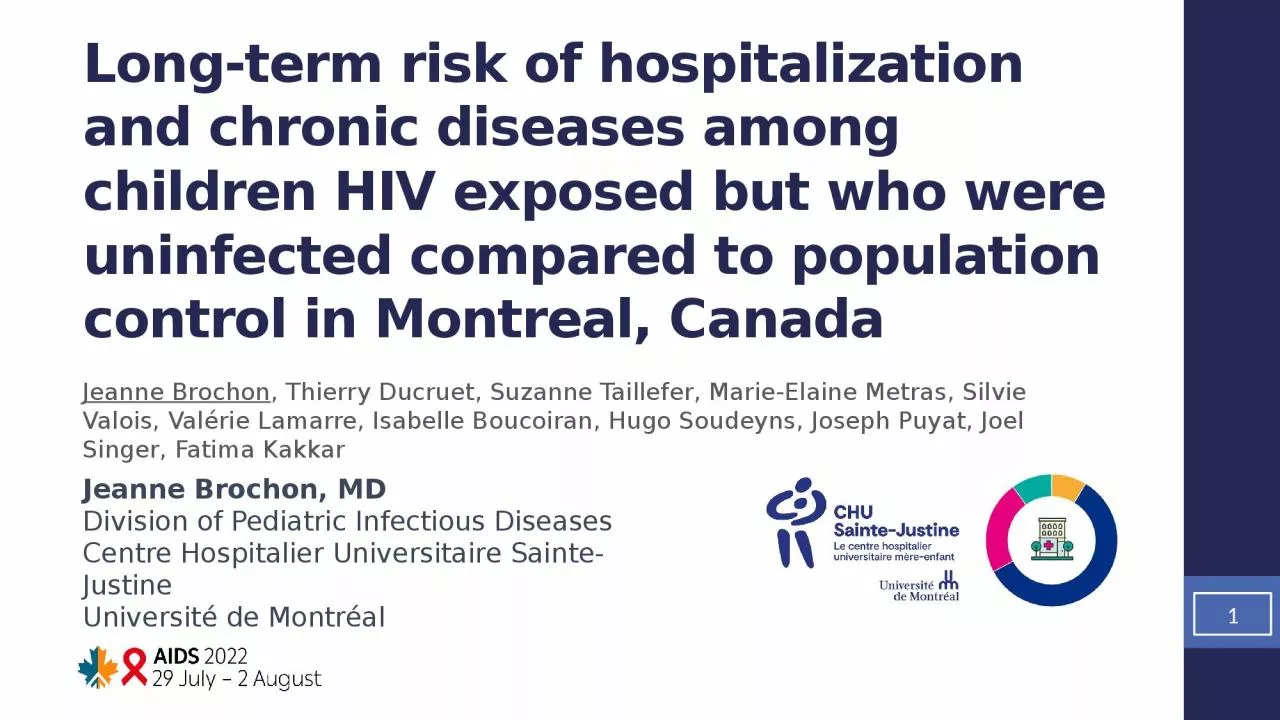

Jeanne Brochon Thierry Ducruet Suzanne Taillefer MarieElaine Metras Silvie Valois Valérie Lamarre Isabelle Boucoiran Hugo Soudeyns Joseph Puyat Joel Singer Fatima Kakkar ID: 1043346
Download Presentation The PPT/PDF document "Long-term risk of hospitalization and ch..." is the property of its rightful owner. Permission is granted to download and print the materials on this web site for personal, non-commercial use only, and to display it on your personal computer provided you do not modify the materials and that you retain all copyright notices contained in the materials. By downloading content from our website, you accept the terms of this agreement.
1. Long-term risk of hospitalization and chronic diseases among children HIV exposed but who were uninfected compared to population control in Montreal, Canada Jeanne Brochon, Thierry Ducruet, Suzanne Taillefer, Marie-Elaine Metras, Silvie Valois, Valérie Lamarre, Isabelle Boucoiran, Hugo Soudeyns, Joseph Puyat, Joel Singer, Fatima KakkarJeanne Brochon, MDDivision of Pediatric Infectious DiseasesCentre Hospitalier Universitaire Sainte-JustineUniversité de Montréal1
2. Financial disclosureNothing to declare2
3. Land acknowledgementWe acknowledge that this work takes place in Tiohtià:ke (Montréal), from where I speak, on the unceded lands of the Kanien’kehá:ka (Mohawk Nation)3
4. Uninfected, but not unaffectedOver the world41 Wedderburn, Lancet, 20222 UNAIDS epidemiological estimates, 2021CHEU2There are an estimated 15.4 million of children HIV-exposed but who are uninfected (CHEU) globally. 1Despite averting HIV infection, there are concerns about the health of CHEU.
5. Mortality1Bacterial infections3Hospitalisation (all cause and ID)2Poor growth and stunting 4Neurological outcomes55Increased risk4 Evans, Clin Infect Dis, 20215 Wedderburn, Lancet, 20226 Gadow, J Dev Behav Pediatr, 20101 Brennan, AIDS, 20162 Anderson, AIDS, 20213 Taron-Brocard, CID, 2014Psychiatric disorders6Data from predominantly resource-limited settings
6. 6Maternal immunesuppressionHIV viremiaART Drug exposure Access to health care ?MitochondrialdysfunctionIncreasedhospitalizationImmunologicalabnormalitiesPreterm deliveryIncreasedmortalitySocio-economic factors ?Infectious diseasesNeurodevelopmentaldisorders?Chronic diseases?Causes likely multifactorialMecanism
7. In a resource-rich setting, with universal access to care,will we see these same outcomes?7Rationale
8. ObjectivesObjectives8
9. MethodsCMIS cohortProspective cohort established in 1988 in Montreal to follow pregnant women living with HIV and their children from birth until early childhoodQuebec public medical services databaseThe Régie assurance maladie du Québec (RAMQ) is a universal health care system that covers all residents of the province regardless of age or incomeIndividuals are assigned a unique lifetime single patient identifier RAMQ database includes all medical services and procedures billed, across all health care settingsMethods9
10. MethodsCHEU from the CMIS were matched (1:3) to a CHUU control from the RAMQ database, identified at random after matching for age, gender, and postal code (neighborhood)1988 – 2016OutcomesHospitalization: Any hospitalization in the province of Quebec registered in the RAMQ databaseChronic conditions: Defined by system à prioriDetermined by ICD-9 codesAnalysisSurvival analysis to compare incidence rate of all-cause hospitalization compared between CHEU and CHUU using Kaplan-Meier curves and Cox Proportional Hazards modelsFor the outcome of any chronic condition, we will present risk-ratios (RR) and 95% confidence intervals (CI) for the first occurrence of each outcome within the two groups Methods10
11. Results: CMIS cohort11NRTI ExposureNNRTI, PI, INSTIBirth yearsCHEU
12. CHEU vs. CHUU controlsCHEUN(%)CHUUN(%)p-valueTotal726 (100)2178 (100)NAFemale sex assigned at birth357 (49.2)1071 (49.2) NAGestational age <37 weeks99 (13.7)164 (8.5)<0.001Follow-up time, median Q1-Q3 (years)11.1 [6.6-15.9]11.1 [6.7-15.8]NAResults12
13. Risk of hospitalization over timeResults: primay outcome13HR= 1.42 [1.26-1.61], p<0.001aHR for gestational age: 1.23 [1.08-1.40], p=0.001HR= 1.21 [1.06-1.40], p=0.006aHR for gestational age: 1.14 [0.99-1.31], p=0.078All hospitalization CHEU vs. CHUUExcluding prolonged birth hospitalizationCHEUCHUUCHEUCHUU
14. Chronic conditions defined by ICD-9 codes14Results
15. Neuropsychiatric conditionsResults: chronic diseases15RR= 1.28 [1.13-1.45], p<0.001
16. Results: chronic diseases16RR= 2.13[1.37-3.33]p<0.001 RR= 1.92[1.14-3.21]p=0.012RR= 1.39[1.10-1.76]p=0.007RR= 2.29[1.12-4.70]p=0.020RR= 1.71[1.20-2.44]p=0.003RR= 4.50[1.27-15.90]p=0.010Specific neuropsychiatric conditions
17. Congenital anomalies 17RR= 1.58 [1.09-2.30], p=0.016 Results: chronic diseases
18. Specific congenital anomaliesResults: chronic diseases18RR= 3.00 [2.13-4.24], p<0.001 RR= 1.37 [1.10-1.69], p=0.004
19. Endocrine system Results: chronic diseases19RR= 0.70 [0.55-0.88], p=0.002
20. Specific endocrine conditions Results: chronic diseases20RR= 2.43 [1.14-1.80], p=0.002RR= 0.52 [0.41-0.66], p<0.001
21. Summary of chronic conditionsResults: chronic diseases21Incidence rate ratiosCHEU (n=726) N(%)CHUU (n=2178)N(%)RR 95%CIp-valueCongenital anomalies40 (5.5)76 (3.5)1.58 [1.09 - 2.3]0.016Neuro-psychiatric disorders241 (33.3)566 (26.1)1.28 [1.13 - 1.45] <0.001Endocrine nutritional, metabolic and immunity disorders79 (10.9)340 (15.7)0.70 [0.55 - 0.88]0.002Respiratory diseases161 (22.3)559 (25.8)0.86 [0.74 - 1.01] 0.06Cardiovascular system diseases21 (2.9)75 (3.5)0.84 [0.52 - 1.35]0.47Neoplasms12 (1.7)45 (2.1)0.8 [0.43 - 1.5]0.89
22. SummaryIncreased risk of hospitalization in CHEU vs. CHUU controls Despite controls matched for socio-economical status (neighborhood), age and gender, and adjustment for gestational age Increased risk of neuro-psychiatric diagnoses in CHEU vs. CHUU controlsSignificant concern given the millions of CHEU globallyConfirms findings from previous cohorts1,2, and clinical realityDiscussion221 Piske, AIDS, 20182 Wedderburn, Lancet, 2022
23. Discussion Study limitationsAdministrative data: ICD9 codes are non-exhaustive, reflect billing not necessarily clinical realityImperfect matching within neighborhoods, and multiple unadjusted confoundersDifferent ART exposure over time, including older regimens no longer used in pregnancyStrengthsLinkage of clinical to administrative data allows for long-term outcomes assessment of CHEU as they move into adulthoodProvides insight into potential signals that could be assessed in larger cohorts (for example: risk of diabetes)Discussion23
24. CHEU: Beyond surviving to thriving?While work into understanding the causes of differences in health outcomes among CHEU and CHUU is ongoing, these data suggest that CHEU could benefit from:Enhanced access to primary care regardless of settingEarly neurodevelopmental assessments and screeningOngoing care beyond time of HIV negative diagnosisConclusion24
25. Acknowledgements25Dr Normand LapointeDr Marc BoucherDr Valerie LamarreDr Chris KaratziosDr Christian RenaudDr Isabelle BoucoiranDr Fatima KakkarDr Soren GanttNathalie PichetteMarie Elaine MetrasPascal BedardSilvie ValoisDr Suzanne TailleferDr Hugo SoudeynsMartine CatyJoanne SamsonThierry Ducruet Patricia ConnollyChantal LapointeDiane NoelAnne Marie VermetteThe CMIS clinical cohort team